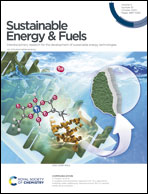Effects of solids retention times on electro-selective fermentation using Scenedesmus acutus biomass†
Abstract
Electro-Selective Fermentation (ESF) is a means to enhance lipid wet extraction from microalgal biomass. The Solids Retention Time (SRT) is a decisive factor for maximizing lipid extraction and recovery, and effective ESF treatment requires a minimum SRT that needs to be determined. The hydraulic retention time (HRT) was manipulated to control the SRT in ESF treating Scenedesmus acutus biomass, since the HRT was almost equal to the SRT in our ESF experiments. An ESF process that started with a ∼6 d SRT achieved high lipid extractability, but with relatively low lipid recovery. Shortening the SRT to ∼2 d yielded slightly lower extractability, but nearly 100% lipid recovery and much higher volumetric productivity, compared to the 6 d SRT. Starting with an ∼2 d SRT yielded much less extractable lipid production that did not increase after the SRT was extended to 6 d in a later stage. Microbial community analysis revealed lingering active fermenters when the SRT switched from long to short, but short to long SRT flushed out fermenters at first, although the fermenters were able to modestly recover after going back to the longer SRT. Thus, starting ESF with a longer SRT was important for selecting a microbial community able to achieve high lipid extractability, even though the subsequent shorter HRT achieved the highest production rate.



 Please wait while we load your content...
Please wait while we load your content...